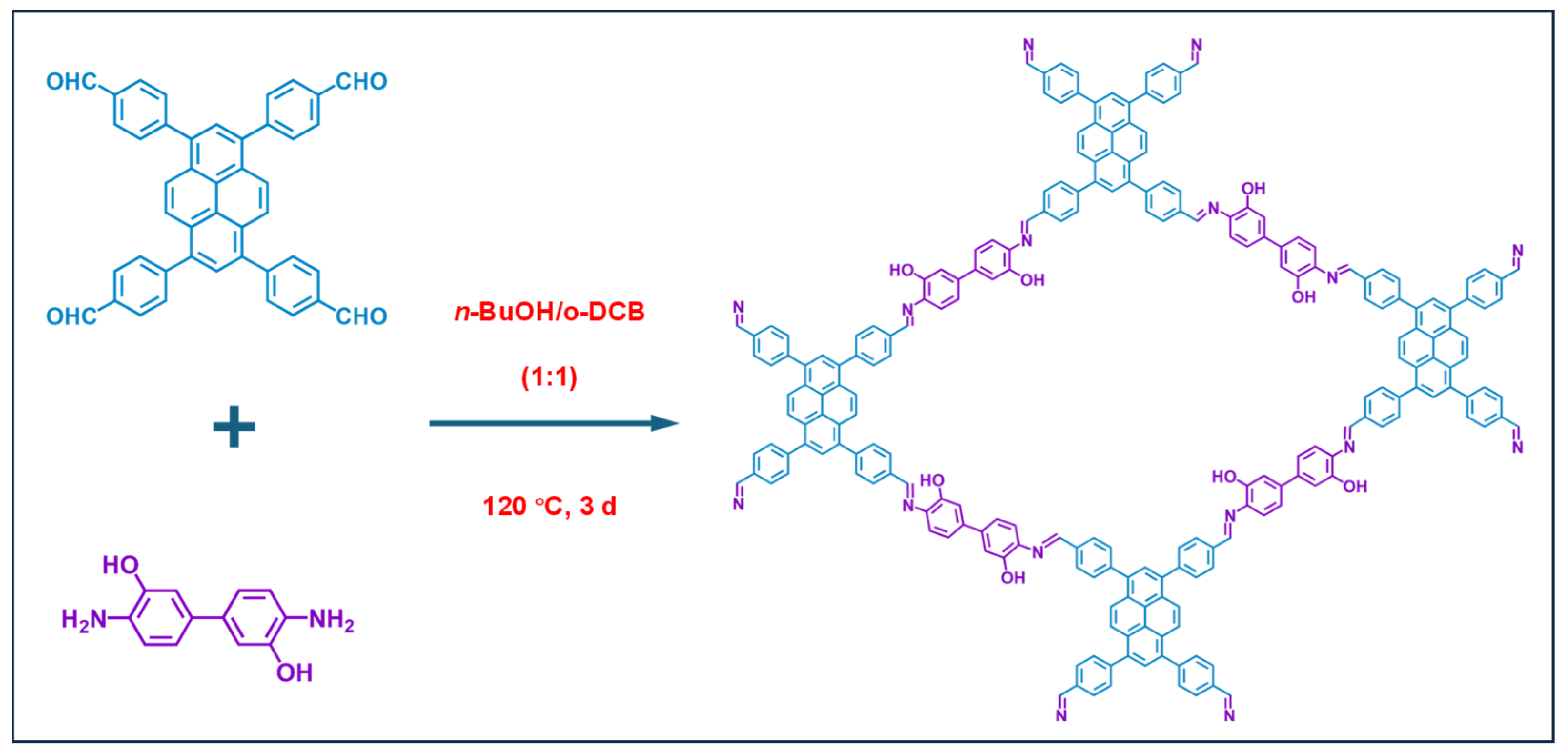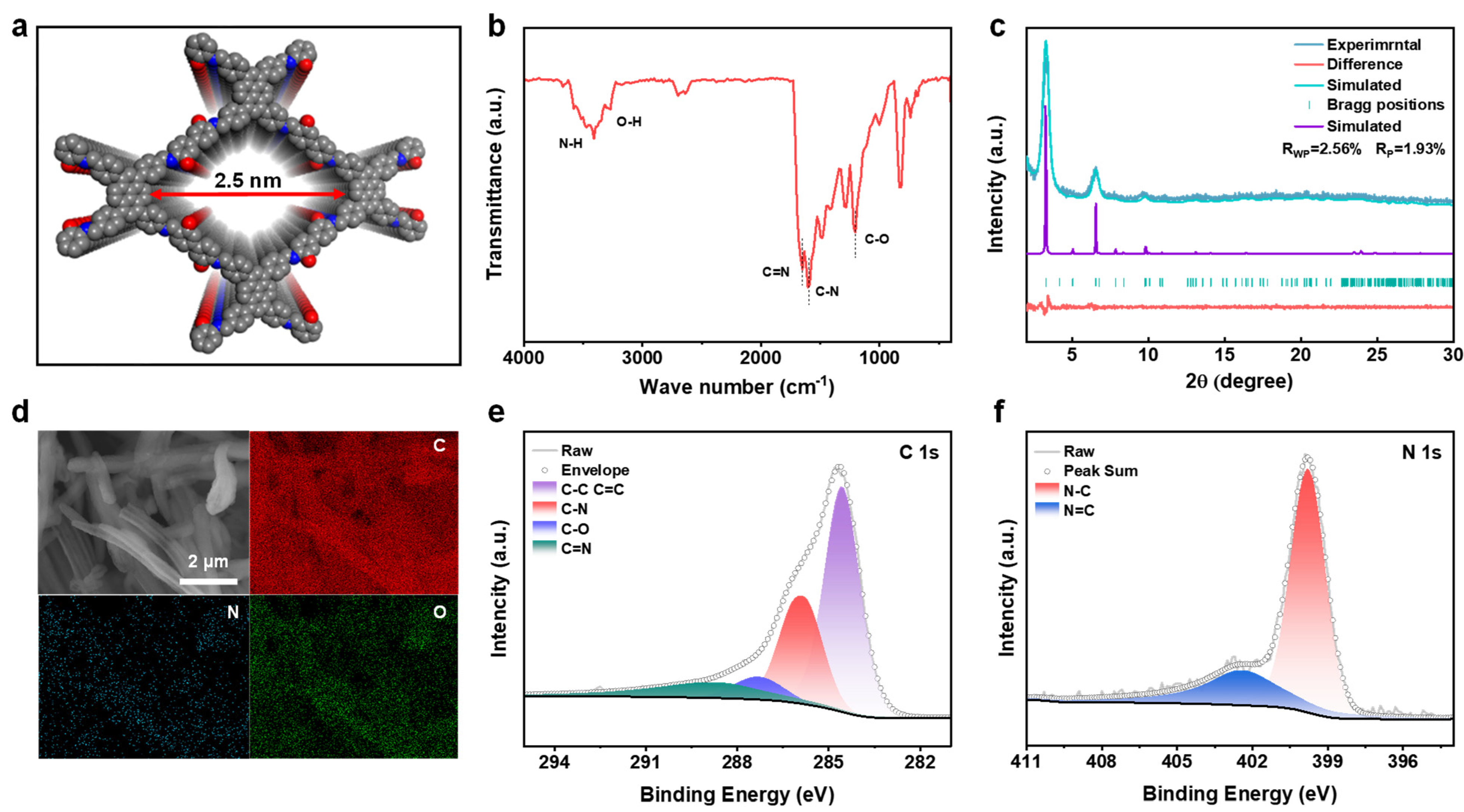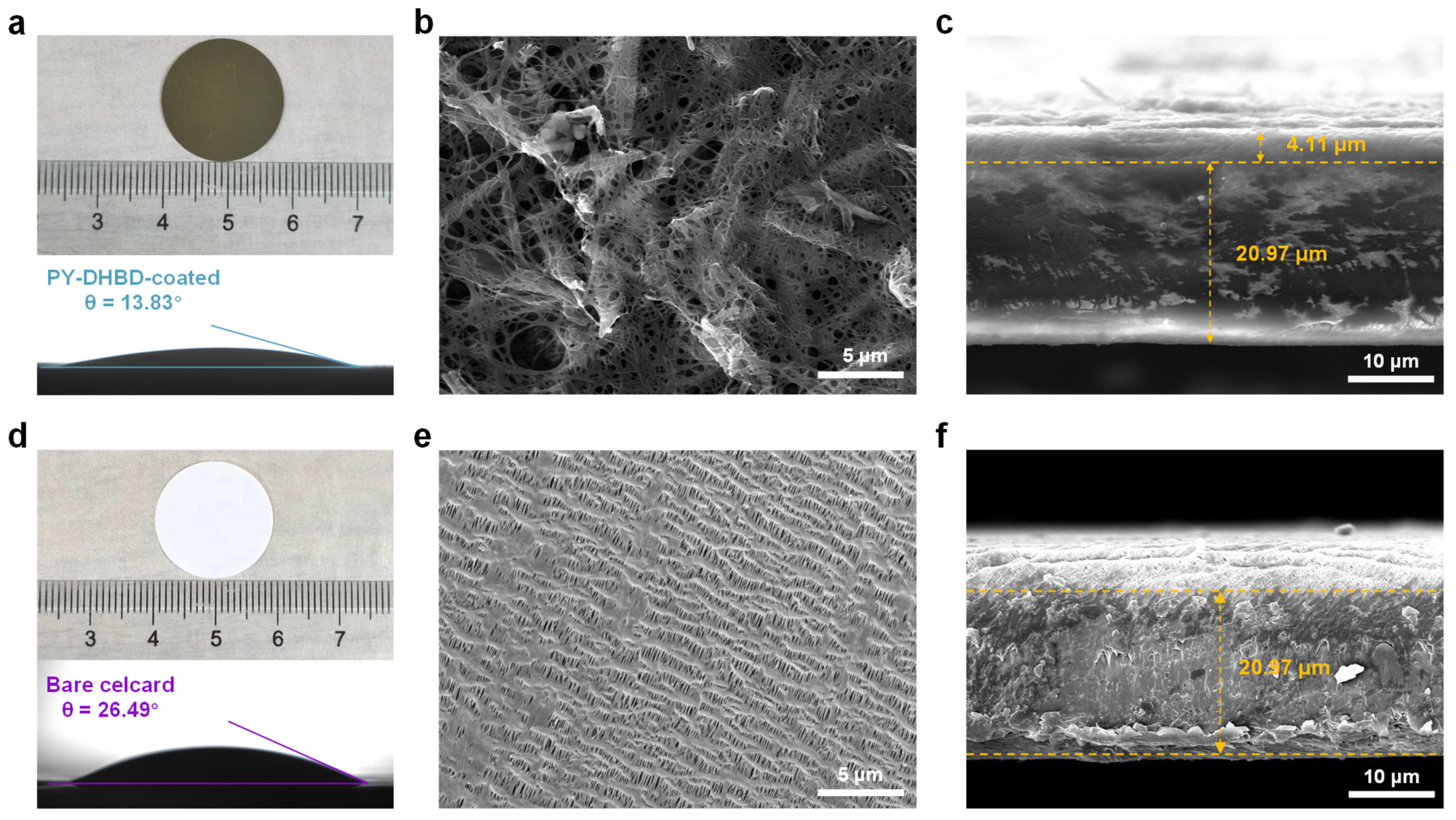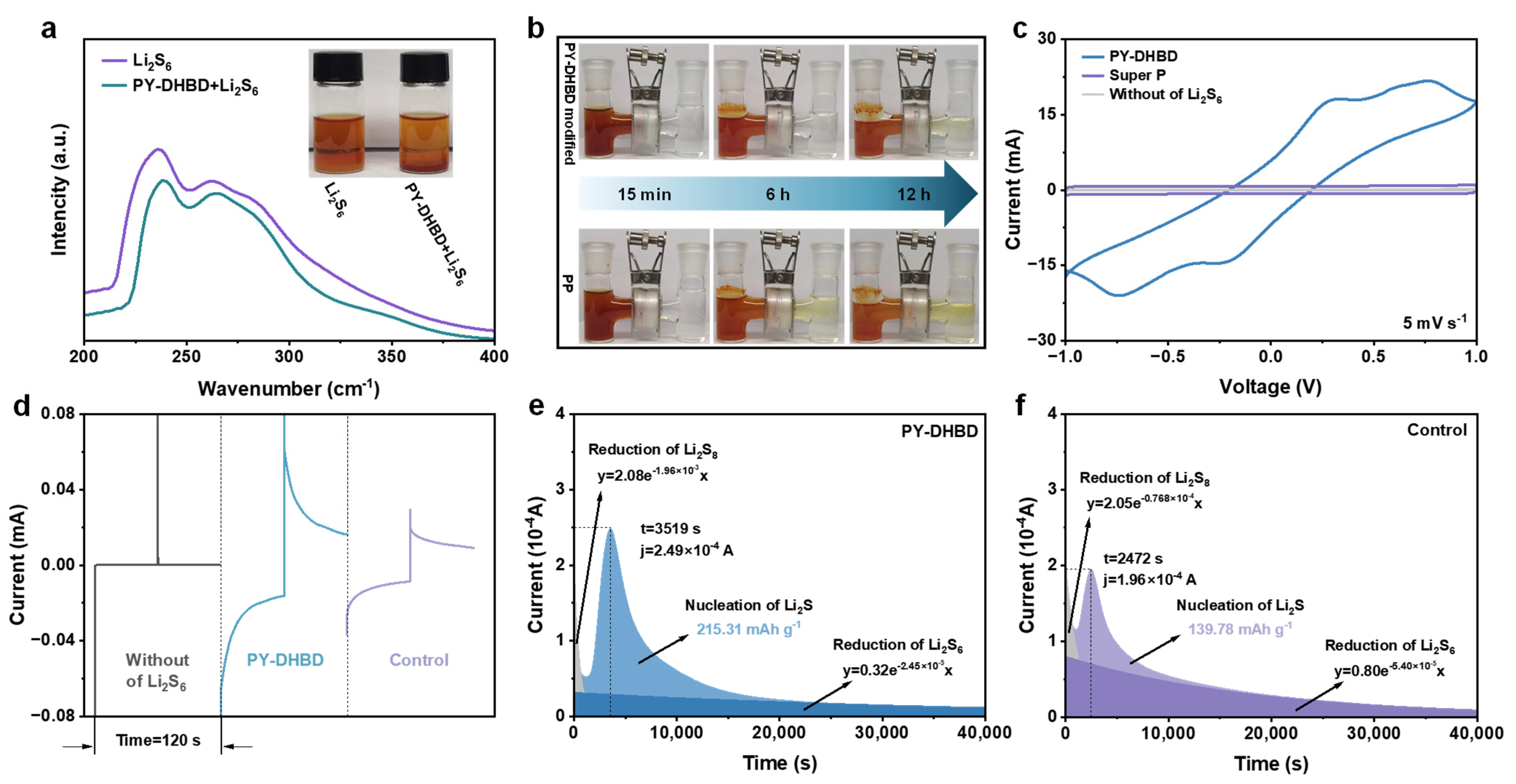Boosting the Performance of Lithium-Sulfur Batteries with PY−DHBD−COF-Enhanced Separators
Abstract
1. Introduction
2. Results and Discussion
3. Materials and Methods
3.1. Synthesis of PY−DHBD−COF and Modified PP Separator
3.2. Characterization
3.3. Preparation of Cathode
3.4. Electrochemical Performance Test
3.5. Visualized Adsorption of Li2S6 Experiments
3.6. Symmetric Cell Measurements
3.7. Li2S Nucleation Experiments
3.8. Lithium-Ion Diffusion Coefficient
4. Conclusions
Supplementary Materials
Author Contributions
Funding
Data Availability Statement
Conflicts of Interest
References
- Yang, Z.; Guo, Z.; Wang, X.; Lu, W.; Wang, Q.; Zhao, Y.; Yao, M.; Gao, P.; Zhang, D.; Du, F. Bi-functional material SnSSe/rGO with anionic vacancies serves as a polysulfide shuttling blocker and lithium dendrite inhibitor. Energy Storage Mater. 2024, 67, 103276. [Google Scholar] [CrossRef]
- Song, M.; Liu, Y.; Hong, J.; Wang, X.; Huang, X. Boosting bidirectional conversion of polysulfide driven by the built-in electric field of MoS2/MoP Mott-Schottky heterostructures in lithium–sulfur batteries. J. Adv. Ceram. 2023, 12, 1872–1888. [Google Scholar] [CrossRef]
- Zhu, Q.; Xu, H.-F.; Shen, K.; Zhang, Y.-Z.; Li, B.; Yang, S.-B. Efficient polysulfides conversion on Mo2CTx MXene for high-performance lithium-sulfur batteries. Rare Met. 2022, 41, 311–318. [Google Scholar] [CrossRef]
- Liu, C.; Qiu, Y.; Liu, Y.; Xu, K.; Zhao, N.; Lao, C.; Shen, J.; Chen, Z. Novel 3D grid porous Li4Ti5O12 thick electrodes fabricated by 3D printing for high performance lithium-ion batteries. J. Adv. Ceram. 2022, 11, 295–307. [Google Scholar] [CrossRef]
- Bai, Y.; Li, J.; Lu, H.; Liu, J.; Ma, C.; Wang, B.; Zhao, X.; Deng, J. Ultrafast high-temperature sintering of high-entropy oxides with refined microstructure and superior lithium-ion storage performance. J. Adv. Ceram. 2023, 12, 1857–1871. [Google Scholar] [CrossRef]
- Gao, F.; Yue, X.-A.; Xu, X.-Y.; Xu, P.; Zhang, F.; Fan, H.-S.; Wang, Z.-L.; Wu, Y.-T.; Liu, X.; Zhang, Y. A N/Co co-doped three-dimensional porous carbon as cathode host for advanced lithium-selenium batteries. Rare Met. 2023, 42, 2670–2678. [Google Scholar] [CrossRef]
- Zhou, J.; Sun, S.; Zhou, X.; Rao, X.; Xu, X.; Zhang, Z.; Pan, Z.; Wang, Q.-C.; Wang, Z.; Wu, Y.; et al. Defect engineering enables an advanced separator modification for high-performance lithium-sulfur batteries. Chem. Eng. J. 2024, 487, 150574. [Google Scholar] [CrossRef]
- Li, S.; Peng, Z.; Fu, X. Zn0.5Co0.5Mn0.5Fe0.5Al0.5Mg0.5O4 high-entropy oxide with high capacity and ultra-long life for Li-ion battery anodes. J. Adv. Ceram. 2023, 12, 59–71. [Google Scholar] [CrossRef]
- He, Y.; Chang, Z.; Wu, S.; Qiao, Y.; Bai, S.; Jiang, K.; He, P.; Zhou, H. Simultaneously Inhibiting Lithium Dendrites Growth and Polysulfides Shuttle by a Flexible MOF-Based Membrane in Li-S Batteries. Adv. Energy Mater. 2018, 8, 1802130. [Google Scholar] [CrossRef]
- Yang, W.-H.; Ni, Z.-C.; You, D.; Hou, J.-Y.; Deng, B.-N.; Huang, R.-W.; Sun, S.-G.; Zhao, J.-B.; Li, X.; Zhang, Y.-Y.; et al. Multifunctional sulfur-immobilizing GO/MXene aerogels for highly-stable and long-cycle-life lithium-sulfur batteries. Rare Met. 2023, 42, 2577–2591. [Google Scholar] [CrossRef]
- Tu, S.; Chen, X.; Zhao, X.; Cheng, M.; Xiong, P.; He, Y.; Zhang, Q.; Xu, Y. A Polysulfide-Immobilizing Polymer Retards the Shuttling of Polysulfide Intermediates in Lithium–Sulfur Batteries. Adv. Mater. 2018, 30, 1804581. [Google Scholar] [CrossRef] [PubMed]
- Xia, S.; Song, J.; Zhou, Q.; Liu, L.; Ye, J.; Wang, T.; Chen, Y.; Liu, Y.; Wu, Y.; van Ree, T. A Separator with Double Coatings of Li4Ti5O12 and Conductive Carbon for Li-S Battery of Good Electrochemical Performance. Adv. Sci. 2023, 10, 2301386. [Google Scholar] [CrossRef]
- Wang, J.; Han, W.-Q. A Review of Heteroatom Doped Materials for Advanced Lithium–Sulfur Batteries. Adv. Funct. Mater. 2022, 32, 2107166. [Google Scholar] [CrossRef]
- Guan, L.; Hu, H.; Li, L.; Pan, Y.; Zhu, Y.; Li, Q.; Guo, H.; Wang, K.; Huang, Y.; Zhang, M.; et al. Intrinsic Defect-Rich Hierarchically Porous Carbon Architectures Enabling Enhanced Capture and Catalytic Conversion of Polysulfides. ACS Nano 2020, 14, 6222–6231. [Google Scholar] [CrossRef] [PubMed]
- Liu, W.; Luo, C.; Zhang, S.; Zhang, B.; Ma, J.; Wang, X.; Liu, W.; Li, Z.; Yang, Q.-H.; Lv, W. Cobalt-Doping of Molybdenum Disulfide for Enhanced Catalytic Polysulfide Conversion in Lithium–Sulfur Batteries. ACS Nano 2021, 15, 7491–7499. [Google Scholar] [CrossRef] [PubMed]
- Song, X.; Tian, D.; Qiu, Y.; Sun, X.; Jiang, B.; Zhao, C.; Zhang, Y.; Fan, L.; Zhang, N. Improving poisoning resistance of electrocatalysts via alloying strategy for high-performance lithium-sulfur batteries. Energy Storage Mater. 2021, 41, 248–254. [Google Scholar] [CrossRef]
- Cheng, Z.; Pan, H.; Zhong, H.; Xiao, Z.; Li, X.; Wang, R. Porous Organic Polymers for Polysulfide Trapping in Lithium–Sulfur Batteries. Adv. Funct. Mater. 2018, 28, 1707597. [Google Scholar] [CrossRef]
- Demir-Cakan, R.; Morcrette, M.; Nouar, F.; Davoisne, C.; Devic, T.; Gonbeau, D.; Dominko, R.; Serre, C.; Férey, G.; Tarascon, J.-M. Cathode Composites for Li–S Batteries via the Use of Oxygenated Porous Architectures. J. Am. Chem. Soc. 2011, 133, 16154–16160. [Google Scholar] [CrossRef]
- Stegbauer, L.; Zech, S.; Savasci, G.; Banerjee, T.; Podjaski, F.; Schwinghammer, K.; Ochsenfeld, C.; Lotsch, B.V. Tailor-Made Photoconductive Pyrene-Based Covalent Organic Frameworks for Visible-Light Driven Hydrogen Generation. Adv. Energy Mater. 2018, 8, 1703278. [Google Scholar] [CrossRef]
- Jiang, C.; Tang, M.; Zhu, S.; Zhang, J.; Wu, Y.; Chen, Y.; Xia, C.; Wang, C.; Hu, W. Constructing Universal Ionic Sieves via Alignment of Two-Dimensional Covalent Organic Frameworks (COFs). Angew. Chem. Int. Ed. 2018, 57, 16072–16076. [Google Scholar] [CrossRef] [PubMed]
- Wang, J.; Qin, W.; Zhu, X.; Teng, Y. Covalent organic frameworks (COF)/CNT nanocomposite for high performance and wide operating temperature lithium–sulfur batteries. Energy 2020, 199, 117372. [Google Scholar] [CrossRef]
- Zhang, F.-M.; Sheng, J.-L.; Yang, Z.-D.; Sun, X.-J.; Tang, H.-L.; Lu, M.; Dong, H.; Shen, F.-C.; Liu, J.; Lan, Y.-Q. Rational Design of MOF/COF Hybrid Materials for Photocatalytic H2 Evolution in the Presence of Sacrificial Electron Donors. Angew. Chem. Int. Ed. 2018, 57, 12106–12110. [Google Scholar] [CrossRef] [PubMed]
- Wu, Z.; Feng, L.; Luo, J.; Zhao, Y.; Yu, X.; Li, Y.; Wang, W.; Sui, Z.; Tian, X.; Chen, Q. Metalation of functionalized benzoquinoline-linked COFs for electrocatalytic oxygen reduction and lithium-sulfur batteries. J. Colloid Interface Sci. 2023, 650, 1466–1475. [Google Scholar] [CrossRef] [PubMed]
- Hu, B.; Xu, J.; Fan, Z.; Xu, C.; Han, S.; Zhang, J.; Ma, L.; Ding, B.; Zhuang, Z.; Kang, Q.; et al. Covalent Organic Framework Based Lithium-Sulfur Batteries: Materials, Interfaces, and Solid-State Electrolytes. Adv. Energy Mater. 2023, 13, 2203540. [Google Scholar] [CrossRef]
- Je, S.H.; Kim, H.J.; Kim, J.; Choi, J.W.; Coskun, A. Perfluoroaryl-Elemental Sulfur SNAr Chemistry in Covalent Triazine Frameworks with High Sulfur Contents for Lithium-Sulfur Batteries. Adv. Funct. Mater. 2017, 27, 1703947. [Google Scholar] [CrossRef]
- Lv, S.; Ma, X.; Ke, S.; Wang, Y.; Ma, T.; Yuan, S.; Jin, Z.; Zuo, J.-L. Metal-Coordinated Covalent Organic Frameworks as Advanced Bifunctional Hosts for Both Sulfur Cathodes and Lithium Anodes in Lithium–Sulfur Batteries. J. Am. Chem. Soc. 2024, 146, 9385–9394. [Google Scholar] [CrossRef] [PubMed]
- Sun, L.; Li, Z.; Zhai, L.; Moon, H.; Song, C.; Oh, K.-S.; Kong, X.; Han, D.; Zhu, Z.; Wu, Y.; et al. Electrostatic polarity-regulated, vinylene-linked cationic covalent organic frameworks as an ionic sieve membrane for long-cyclable lithium-sulfur batteries. Energy Storage Mater. 2024, 66, 103222. [Google Scholar] [CrossRef]
- Cai, S.; Ma, R.; Ke, W.; Zhang, H.; Liu, Y.; Jiao, M.; Tian, Y.; Fang, Y.; Wu, M.; Zhou, Z. Flower-like covalent organic frameworks as host materials for high-performance lithium-sulfur batteries. Chem. Eng. J. 2024, 491, 151979. [Google Scholar] [CrossRef]
- Li, J.; Jing, X.; Li, Q.; Li, S.; Gao, X.; Feng, X.; Wang, B. Bulk COFs and COF nanosheets for electrochemical energy storage and conversion. Chem. Soc. Rev. 2020, 49, 3565–3604. [Google Scholar] [CrossRef]
- Xu, J.; Zhang, H.; Yu, F.; Cao, Y.; Liao, M.; Dong, X.; Wang, Y. Realizing All-Climate Li-S Batteries by Using a Porous Sub-Nano Aromatic Framework. Angew. Chem. Int. Ed. 2022, 61, e202211933. [Google Scholar] [CrossRef]
- Cao, Y.; Liu, C.; Wang, M.; Yang, H.; Liu, S.; Wang, H.; Yang, Z.; Pan, F.; Jiang, Z.; Sun, J. Lithiation of covalent organic framework nanosheets facilitating lithium-ion transport in lithium-sulfur batteries. Energy Storage Mater. 2020, 29, 207–215. [Google Scholar] [CrossRef]
- Xu, J.; An, S.; Song, X.; Cao, Y.; Wang, N.; Qiu, X.; Zhang, Y.; Chen, J.; Duan, X.; Huang, J.; et al. Towards High Performance Li–S Batteries via Sulfonate-Rich COF-Modified Separator. Adv. Mater. 2021, 33, 2105178. [Google Scholar] [CrossRef] [PubMed]
- Yan, W.; Gao, X.; Yang, J.-L.; Xiong, X.; Xia, S.; Huang, W.; Chen, Y.; Fu, L.; Zhu, Y.; Wu, Y. Boosting Polysulfide Catalytic Conversion and Facilitating Li+ Transportation by Ion-Selective COFs Composite Nanowire for Li-S Batteries. Small 2022, 18, 2106679. [Google Scholar] [CrossRef] [PubMed]
- Li, Y.; Yang, L.; He, H.; Sun, L.; Wang, H.; Fang, X.; Zhao, Y.; Zheng, D.; Qi, Y.; Li, Z.; et al. In situ photodeposition of platinum clusters on a covalent organic framework for photocatalytic hydrogen production. Nat. Commun. 2022, 13, 1355. [Google Scholar] [CrossRef] [PubMed]
- Lu, Q.; Ma, Y.; Li, H.; Guan, X.; Yusran, Y.; Xue, M.; Fang, Q.; Yan, Y.; Qiu, S.; Valtchev, V. Postsynthetic Functionalization of Three-Dimensional Covalent Organic Frameworks for Selective Extraction of Lanthanide Ions. Angew. Chem. Int. Ed. 2018, 57, 6042–6048. [Google Scholar] [CrossRef]
- Yao, L.; Zhang, J.; Xia, J.; Wu, H.; Li, S.; Qian, M.; Li, Z. β-ketoenamine covalent organic frameworks based magnetic solid-phase microextraction for rapid determination of 12 organophosphate esters in surface water. Microchem. J. 2024, 200, 110283. [Google Scholar] [CrossRef]
- Wang, J.; Liu, L.; Ling, Z.; Yang, J.; Wan, C.; Jiang, C. Polymer lithium cells with sulfur composites as cathode materials. Electrochim. Acta. 2003, 48, 1861–1867. [Google Scholar] [CrossRef]
- Xia, P.; Li, S.; Yuan, L.; Jing, S.; Peng, X.; Lu, S.; Zhang, Y.; Fan, H. Encapsulating CoRu alloy nanocrystals into nitrogen-doped carbon nanotubes to synergistically modify lithium-sulfur batteries separator. J. Membr. Sci. 2024, 694, 122395. [Google Scholar] [CrossRef]
- Hua, W.; Li, H.; Pei, C.; Xia, J.; Sun, Y.; Zhang, C.; Lv, W.; Tao, Y.; Jiao, Y.; Zhang, B.; et al. Selective Catalysis Remedies Polysulfide Shuttling in Lithium-Sulfur Batteries. Adv. Mater. 2021, 33, 2101006. [Google Scholar] [CrossRef]
- Ye, C.; Jiao, Y.; Jin, H.; Slattery, A.D.; Davey, K.; Wang, H.; Qiao, S.-Z. 2D MoN-VN Heterostructure To Regulate Polysulfides for Highly Efficient Lithium-Sulfur Batteries. Angew. Chem. Int. Ed. 2018, 57, 16703–16707. [Google Scholar] [CrossRef] [PubMed]






Disclaimer/Publisher’s Note: The statements, opinions and data contained in all publications are solely those of the individual author(s) and contributor(s) and not of MDPI and/or the editor(s). MDPI and/or the editor(s) disclaim responsibility for any injury to people or property resulting from any ideas, methods, instructions or products referred to in the content. |
© 2024 by the authors. Licensee MDPI, Basel, Switzerland. This article is an open access article distributed under the terms and conditions of the Creative Commons Attribution (CC BY) license (https://creativecommons.org/licenses/by/4.0/).
Share and Cite
He, H.; Wang, W.; Guo, X. Boosting the Performance of Lithium-Sulfur Batteries with PY−DHBD−COF-Enhanced Separators. Inorganics 2024, 12, 218. https://doi.org/10.3390/inorganics12080218
He H, Wang W, Guo X. Boosting the Performance of Lithium-Sulfur Batteries with PY−DHBD−COF-Enhanced Separators. Inorganics. 2024; 12(8):218. https://doi.org/10.3390/inorganics12080218
Chicago/Turabian StyleHe, Hong, Wei Wang, and Xiaobei Guo. 2024. "Boosting the Performance of Lithium-Sulfur Batteries with PY−DHBD−COF-Enhanced Separators" Inorganics 12, no. 8: 218. https://doi.org/10.3390/inorganics12080218
APA StyleHe, H., Wang, W., & Guo, X. (2024). Boosting the Performance of Lithium-Sulfur Batteries with PY−DHBD−COF-Enhanced Separators. Inorganics, 12(8), 218. https://doi.org/10.3390/inorganics12080218




